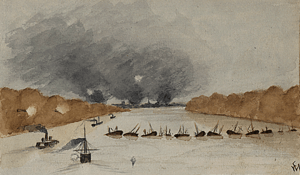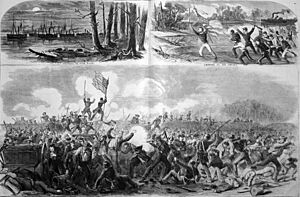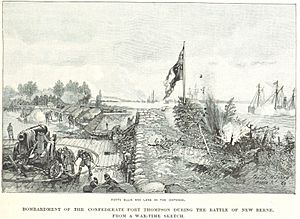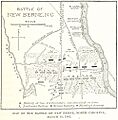Battle of New Bern (1862) facts for kids
Quick facts for kids Battle of New Bern |
|||||||
|---|---|---|---|---|---|---|---|
| Part of the American Civil War | |||||||
 The advance of the Gunboats up the river to New Berne, N. Carolina. Passing the Barricade by Herbert Eugene Valentine |
|||||||
|
|||||||
| Belligerents | |||||||
| Commanders and leaders | |||||||
| Units involved | |||||||
| Coast Division North Atlantic Blockading Squadron |
1st Division, Department of North Carolina | ||||||
| Strength | |||||||
| 13 infantry regiments (11,000) 14 gunboats |
6 infantry regiments (4,000) 1 cavalry regiment |
||||||
| Casualties and losses | |||||||
| 90 killed 380 wounded 1 missing |
64 killed 101 wounded 413 captured or missing |
||||||
The Battle of New Bern was a big fight during the American Civil War. It happened on March 14, 1862, near New Bern, North Carolina. The Union Army, led by General Ambrose Burnside, attacked the city. They were helped by Union Navy ships.
The Confederate soldiers, led by General Lawrence O'B. Branch, tried to defend New Bern. They were fewer in number and not as well trained. Even though they had built defenses, the Union soldiers found a weak spot. They broke through the Confederate lines. This forced the Confederates to retreat far away to Kinston. New Bern then came under Union control and stayed that way for the rest of the war.
Contents
Why was New Bern important?
New Bern is located on the Neuse River. It was an important city because of its railroad connection. The railroad linked the coast to the inner parts of North Carolina. This railroad was vital for supplying the Confederate Army of Northern Virginia. If the Union captured New Bern, they could cut off these supplies. This would hurt the Confederate war effort.
The land around New Bern was mostly flat and sometimes marshy. There were also many small rivers and creeks. The Trent River separated New Bern from the land to its south. Another creek, Slocum's Creek, was where the Union forces planned to land.
Getting Ready for Battle
After North Carolina joined the Confederacy, its defenses were not a top priority. The Confederate government focused on protecting its capital in Richmond, Virginia. This meant North Carolina had fewer trained soldiers and less equipment.
General Daniel Harvey Hill first set up defenses around New Bern. He built strong walls called "breastworks" and forts. One main fort was Fort Thompson, which had 13 cannons. The Confederates also blocked the Neuse River with underwater obstacles. These included piles of wood, torpedoes (old-fashioned mines), and sunken ships. The goal was to stop Union ships from sailing up the river.
General Hill was later moved to Virginia. General Lawrence O'B. Branch took over. His forces were much smaller than needed. He had about 4,000 men, but many were poorly trained militia. They were also often sick.
In February 1862, Union forces captured Roanoke Island. This gave them control of the nearby sounds. Now, cities like New Bern were open to attack. General Burnside decided to capture New Bern next.
General Branch knew New Bern was important. He tried to extend his defense lines. But he made a mistake by using a small creek as part of his line. This created a weak spot in the middle of his defenses. This weak spot was guarded by his least experienced soldiers.
Who Fought?
Union Forces
The Union Army's Coast Division had about 11,000 soldiers. They were supported by 14 Navy gunboats. Their main leaders were Brigadier General Ambrose Burnside and Commander Stephen C. Rowan.
Confederate Forces
The Confederate defenders had about 4,000 men. These included infantry, cavalry, and artillery from North Carolina. They were led by Brigadier General Lawrence O'B. Branch. They had ten cannons and river blockades. Forts like Lane, Ellis, Allen, Thompson, and Dixie also helped defend the area.
The Battle Begins
The Union Advance
On March 11, 1862, Union soldiers boarded their ships at Roanoke Island. They set sail the next morning with 14 Navy gunboats. They sailed across Pamlico Sound and into the Neuse River. They stopped near Slocum's Creek as night fell.
At dawn on March 13, Union troops started landing. Confederate soldiers tried to stop them but were quickly pushed back by fire from the gunboats. Burnside spent the morning getting his men and equipment ashore.
Around noon, the Union soldiers began marching towards the Confederate lines. It started to rain, turning the road into thick mud. Moving was very difficult. The Union gunboats moved ahead, firing at places where Confederates might be hiding. This made the Confederates pull back to their main defense line at Fort Thompson.
By the end of the day, the Union army was about two miles from the Fort Thompson line. They stopped for the night. Their cannons, which were hard to move in the mud, didn't arrive until early the next morning.
The Fight

On the morning of March 14, a thick fog covered the battlefield. General Burnside ordered his troops to attack the Confederate defenses. The Union soldiers didn't know that the Confederate line stretched further than they thought.
The Union Army attacked the Confederate lines. On the Confederate side, General Branch had placed his regiments along the defense line. The weakest part of his line was where the railroad crossed a small creek. This spot was defended by poorly trained militia.
Union General Reno ordered an attack on the Confederate right side. At first, the attack was pushed back. Then, General Burnside sent in his reserve troops. The 4th Rhode Island Regiment, led by Colonel Isaac P. Rodman, launched another attack. This time, they succeeded! They captured nine cannons and got behind the Confederate defenses.
At this point, the Confederate line broke. The inexperienced militia soldiers fled, leaving their flanks open. General Branch tried to send in reserves, but it was too late. The Confederate line collapsed, and a full retreat began.
The retreating Confederates ran across the bridge over the Trent River into New Bern. They quickly burned the bridge to stop the Union from following. Some Confederate soldiers were left behind and captured. They also burned the railroad bridge.
While the land battle was happening, Union gunboats moved up the river. They passed the river obstacles with little damage. They then shelled Fort Thompson. When the fort was abandoned, the gunboats moved into New Bern. They fired on the retreating Confederate troops, stopping them from regrouping. The Confederates had to flee all the way to Kinston.
With both bridges destroyed, Union soldiers had to be ferried across the river by the gunboats. The Confederates lost 64 killed, 101 wounded, and 413 captured or missing. The Union lost 90 killed, 380 wounded, and one man captured.
What Happened Next?
New Bern was captured and stayed under Union control for the rest of the war. This victory was a turning point for Union control of the North Carolina coast. The Union also gained more space for camps and housing for refugees.
After New Bern, Burnside focused on capturing the port at Beaufort. Beaufort was defended by Fort Macon. The Union quickly took Morehead City and Beaufort. The siege of Fort Macon began soon after.
Battlefield Today
The battlefield is now a preserved site called the New Bern Battlefield Site. Groups like the Civil War Trust have helped save about 25 acres (0.10 km²) of the battlefield.
Images for kids
-
The present-day location of Fort Thompson. Only the earthenworks remain. The Neuse River can be seen in the background.





